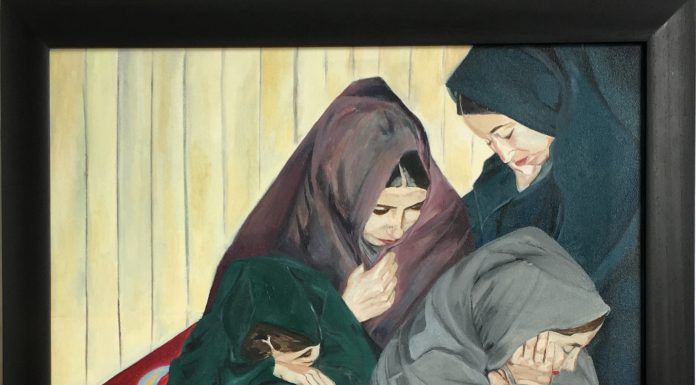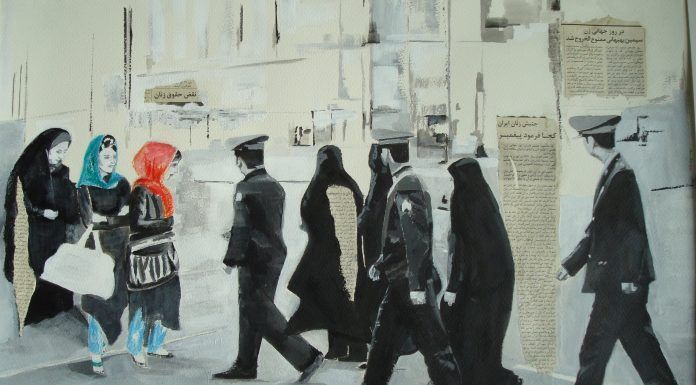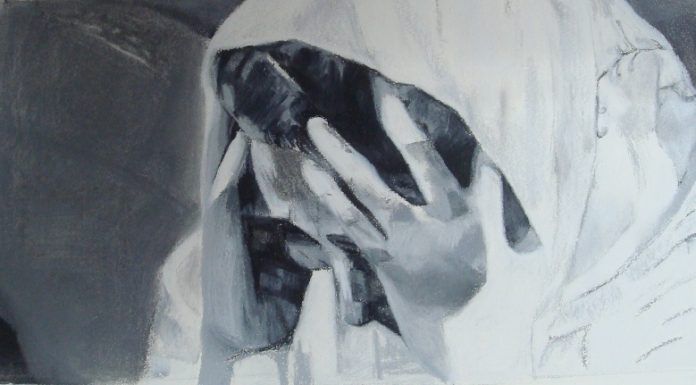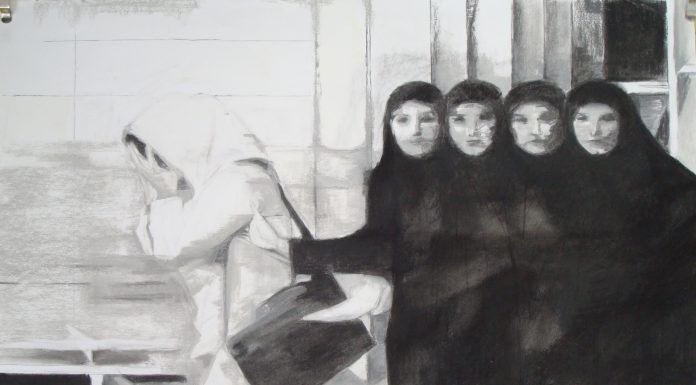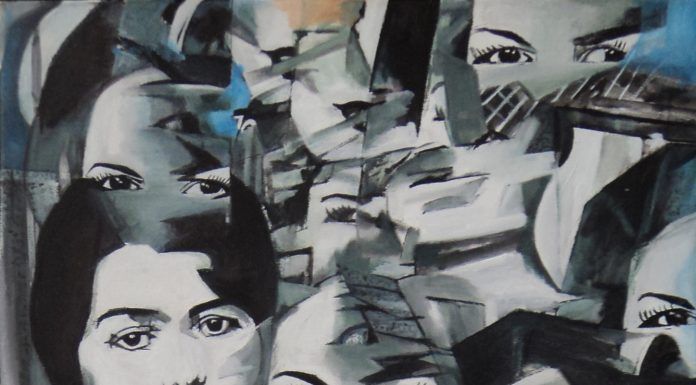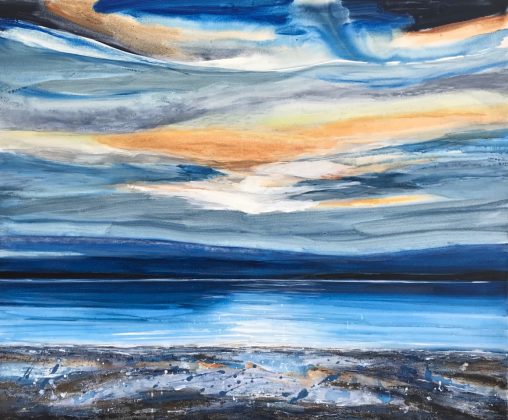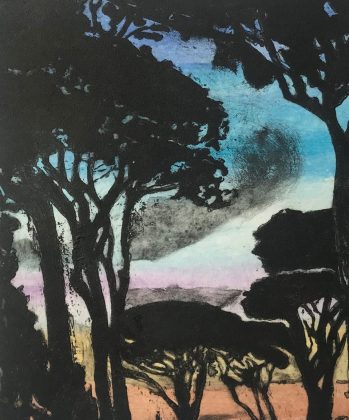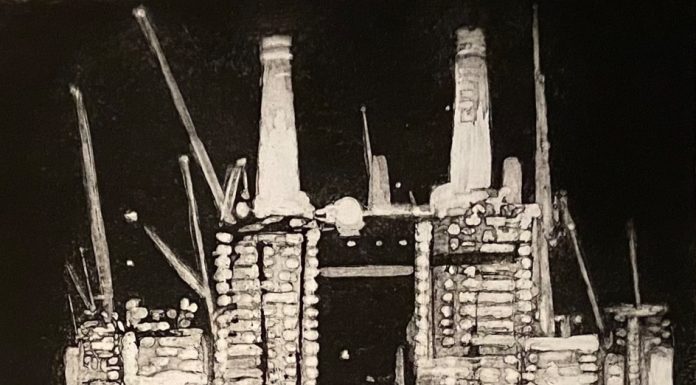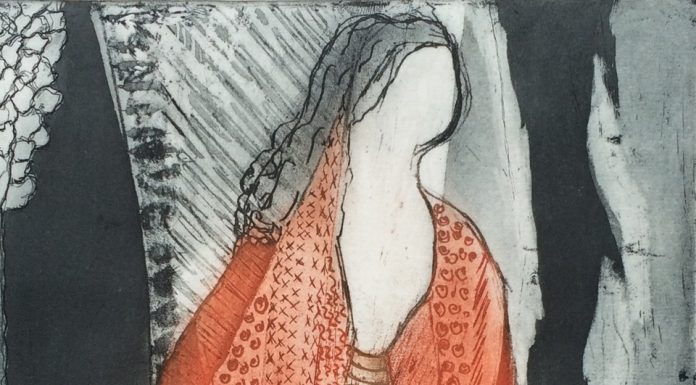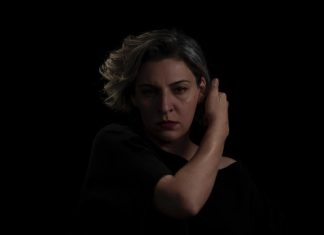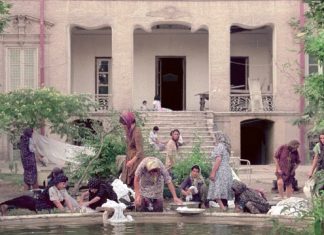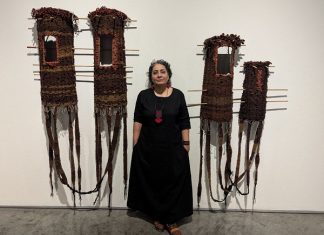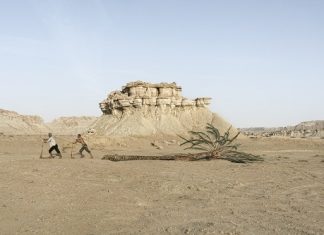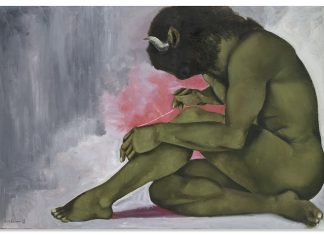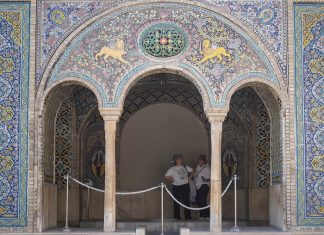By Firouzeh Nabavi
Steps away from the blue-fronted London bookstore made famous by the movie “Notting Hill” is a bakery-turned-art-gallery featuring paintings and etchings by the Iranian-born artist Mandana Khonsari.
Born and raised in Iran, Khonsari has a wide range of works on display at The Bakery on Portobello Road: from delicate etchings of figures, street views and London Bridge to landscapes, seascapes and large abstract canvases covered with gorgeous splashes of color.
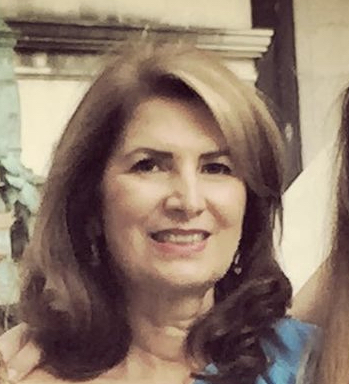
The artist’s father, Dr. Assadollah Alebouyeh, was a Professor of Mathematics at Tehran University and a former acting Minister of Culture. Her husband, Dr. Mehrdad Khonsari, is a former Iranian diplomat, lifelong politician, and director of the Iranian Center for Policy Studies.
Khonsari’s work is on show in an atmospheric artist-run gallery on Portobello Road — a 19th-century bakery that still retains its black cast-iron oven and granary. It is run by the artist Kate Domash, who had her first exhibition there and decided to turn it into a space with rotating shows of nine artists including herself and Khonsari.
Kayhan Life stopped by The Bakery recently for a conversation with Khonsari about her life and work.
You have been active as a painter and printmaker for decades. Your family must have realized when you were a little girl that you had a talent for drawing and painting?
Yes, they did. My father was always persuading me to follow that dream and that passion. But I was very studious, and I thought I should pursue a more serious line of studying.
Where did you grow up?
I grew up in Tehran and went to the Kharazmi school in Iran until I was 18. I was supposed to go to America to study, but then I met my husband. Our parents were good friends. So I got married at the age of 18, stayed in Iran for one year and went to Damavand University.
We left Tehran in 1975. I attended Tufts University and majored in economics, but also did a lot of painting courses while I was there. My husband was then transferred to the Iranian Embassy in London, so I continued my studies at University College London, and transferred my credits over to Tufts University to get my degree.
What did you do in those early years in London?
I had my two daughters, then started working, first in a parliamentary office for a couple of years, then at Lloyds Bank. In the year 2000, I decided that I wanted to pursue my passion, which has always been art. So I went back to studying art, got my diploma from the Putney School of Art and Design, and got my studio in Wandsworth, in south London.
How has your artistic career been since then?
I have been involved with many galleries, going to my studio every day, and just pursuing my passion. I call myself a semi-abstract contemporary artist. I do a lot of landscapes and seascapes. For me, they are emotional spaces where I can convey the connection between myself and the land, sky, and sea. I like the textural quality of landscape, of nature. I like to put that in my paintings.
[aesop_image img=”https://kayhanlife.com/wp-content/uploads/2022/03/Flourish_-Oil-on-canvas56cmx56cm-framed50cmx50cm-unframed.jpeg” panorama=”off” credit=”Flourish. Oil on canvas,56cmx56cm framed,50cmx50cm.” align=”center” lightbox=”on” captionsrc=”custom” captionposition=”left” revealfx=”off” overlay_revealfx=”off”]
Did you travel to Iran at all after 1979?
I only traveled to Iran once after the Revolution, in 2000. I visited my father, and the advice that he gave me when I left Iran was to pursue my passion. That was the last time I saw my father in person. He died a year later.
In the early 2000s, not long after your trip to Iran, you started a series of paintings of Iranian women, including the painting “Regression.” Can you speak about that?
“Regression” is an image of my grandmother, my mother and myself, and it shows how we have regressed as a consequence of the Islamic Revolution. For four or five years, I did paintings on the theme of women in Iran. I felt that as women, we didn’t have any control over our destiny. All of our rights were taken away from us. And I thought I needed to express all of those feelings and emotions through painting.
My mother died in 2008 before I was able to show her the “Regression” painting, which I had talked to her about. She had been very excited to see it, but sadly died without seeing it.
Why did you focus on the plight of Iranian women so many years after the Revolution?
Until that point, life as a mother was taking a lot of my time. My husband was traveling quite a lot for his work. His political life was always somehow intertwined with our family life. And I witnessed his interviews, his passion and his struggles for the Iranian people.
When I was in control of my time, and I had the tools to deal with this struggle of women that was very close to my heart, I started painting and expressing my feelings in these paintings.
Are you still engaged in figurative painting?
Yes — I haven’t given up figurative painting. I keep adding new work to my collection of figurative works, which I would like to exhibit in one major solo exhibition.
Recently, I’ve also done a self- portrait, which I haven’t shown to anybody yet, except my close family.
Have you been painting and exhibiting regularly in London in the past 20 years?
Yes, quite regularly. I have been doing a lot of commissions, and participating in group shows at the Mall Galleries and in many other spaces around London.
In 2016, a major global company purchased more than 30 of my paintings for its headquarter in London. That was a huge boost for my art and my confidence as an artist.
Iranian contemporary art has become very fashionable in recent years, and there’s been speculation around it. I wondered whether you were caught up in this movement and what you thought of it.
To me, making art has never been a means of making money. It has always been just a passion — a way to express myself that is easier for me. I’m not very good with words. Through the medium of art, I can express how I feel.
I never got caught up in the movement that you’re referring to. For me, art was just following a way of life that was different from what I was used to. And I loved it. It gave me freedom to go to my studio. I felt like I had this sanctuary. I completely involved myself with art.
When I paint, it feels like I am very close to my intuition, to my inner self. And I love that feeling. I like the privacy of just doing what I do, and not making a big fuss over myself.
What is the connection that you feel to Iran today?
While it really made me sad when I visited Iran, I am very proud of my culture, my country, my people. I try to manifest that in my painting somehow. I have done etchings that bring out some of that Persian background.
I also think that the colors that I use are colors that I was brought up with. I only ever visited maybe two or three cities in Iran by the time I left. But Isfahan was an amazing place, so beautiful. The blue color of the tiles used in the mosques and the palaces kind of sits in your mind. I have used that color in many of my paintings.
Colors are particular to one’s culture, because somehow they come out without your being aware. You have a sort of innate feeling to use those colors. Sometimes it can be a little bit too strong for people who live in the West, because they’re not used to having strong colors. For us, strong colors are important. It’s part of our culture: vibrant, strong hues. So I tend to use those a lot.
What does art bring to you now?
That desire to paint landscapes and seascapes and show the emotional connection that I have with nature.
I also like open spaces. They give me some sort of freedom, as well as a place to think and to be with nature. I like the energy that nature has to offer.
For more information:

